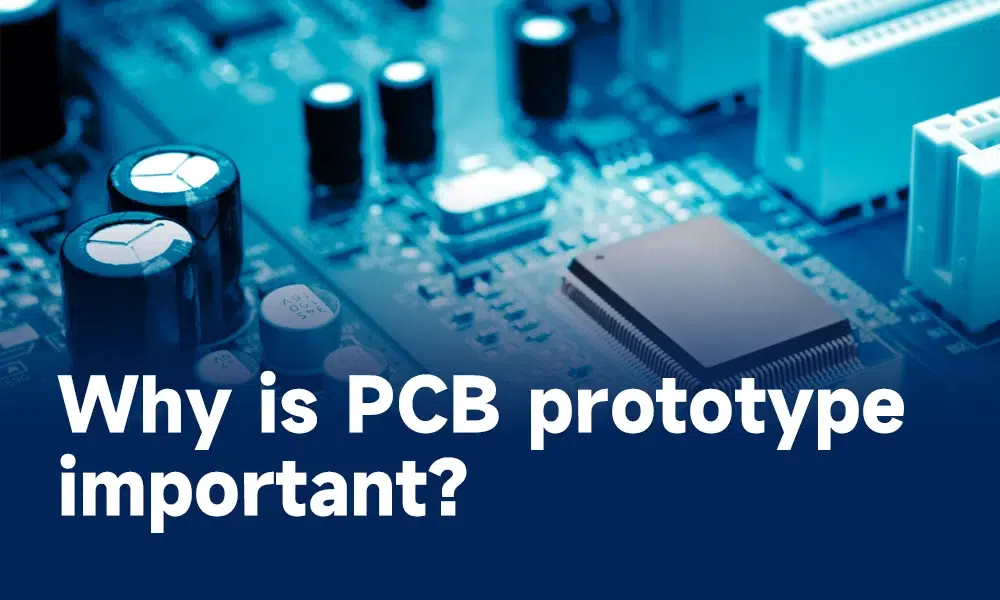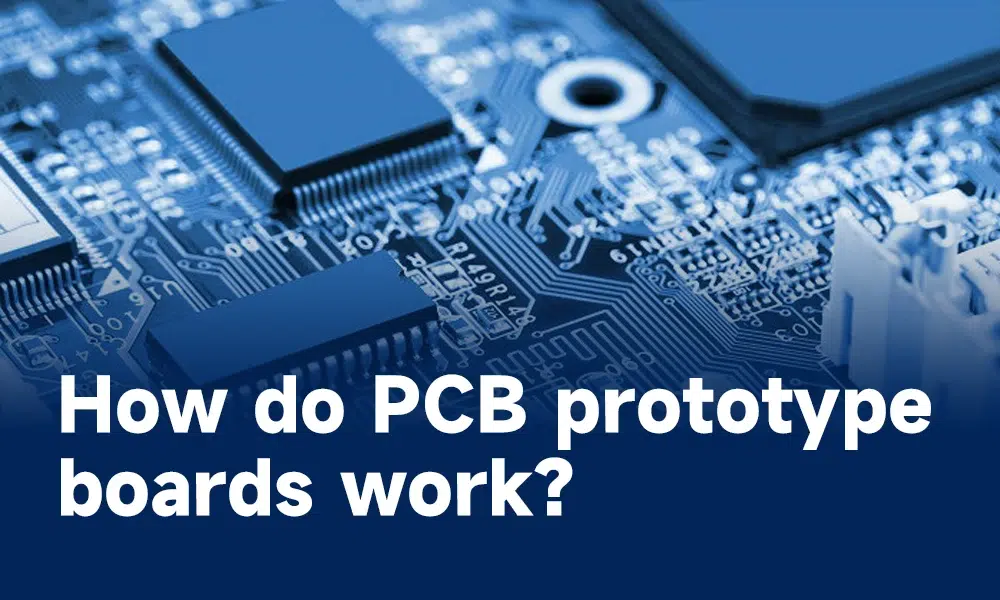A PCB prototype is an initial version of a printed circuit board, used to test and validate a design before full-scale production. It serves as a trial model, allowing engineers to assess functionality, identify flaws, and make necessary adjustments early in the development process. PCB prototypes facilitate thorough testing, ensuring the design meets performance standards and functional requirements.
They play a crucial role in refining and perfecting circuit layouts, optimizing for performance, reliability, and manufacturability. These prototypes minimize risks, reduce production costs, and expedite the development of electronic devices by allowing for iterative improvements before mass manufacturing.
What is a PCB prototype?
A PCB prototype is a sample or early version of a printed circuit board (PCB) designed to validate the functionality, design, and manufacturability of the final product before mass production. It serves as a testing platform to identify and rectify any potential issues or flaws in the design, ensuring that the final PCB functions correctly and meets the required specifications.
Prototyping involves creating a small batch of PCBs using the same processes and materials intended for mass production. These prototypes allow engineers and designers to test the circuit’s functionality, verify connections, assess signal integrity, and evaluate the overall performance of the board.
PCB prototypes are crucial in the product development cycle, offering an opportunity to iterate and refine the design based on testing results. They help identify any design flaws, compatibility issues, or manufacturing challenges early in the process, saving time and resources during the later stages of production.
Why is PCB prototype important?

Design Validation: Prototypes offer the chance to verify and validate a design before mass production. They help detect and rectify potential flaws or errors in the circuit layout, ensuring functionality and reliability.
Cost-Efficiency: Identifying issues in the early stages through prototyping helps avoid expensive errors in mass production. Correcting design flaws during prototyping is significantly cheaper than modifying or recalling products already in production.
Time Savings: Prototyping accelerates the development process by allowing for iterative improvements. It enables engineers to quickly test and refine designs, reducing the time required to finalize a product.
Performance Evaluation: Prototypes facilitate thorough testing under various conditions, ensuring the product meets performance standards, withstands environmental factors, and operates reliably in different scenarios.
Customization and Innovation: Prototyping encourages innovation by providing a platform for experimenting with new ideas and functionalities. It allows for customization and adaptation of designs to meet specific requirements.
Risk Mitigation: By identifying and resolving issues early in the development phase, prototypes mitigate risks associated with the final product’s performance, reliability, and compliance with industry standards.
Improved Communication: Prototypes serve as a tangible representation of the final product. They aid in communicating ideas and concepts between designers, engineers, stakeholders, and potential investors.
Market Validation: Prototyping enables the presentation of a tangible product to potential investors or customers, allowing for feedback that can be incorporated into the final design, increasing its market acceptance.
Overall, PCB prototypes are invaluable in ensuring that the final product meets quality standards, functions as intended, and minimizes risks associated with mass production. They serve as a bridge between the design phase and mass manufacturing, contributing significantly to product success and reliability.
When should a PCB prototype be required?
PCB prototypes are essential in various scenarios:
New Product Development:
Proof of Concept: To validate the functionality and feasibility of a new design or concept.
Design Verification: Ensuring that the designed PCB meets the intended specifications before full production.
Iterative Development: Allowing for design iterations and modifications to refine the product.
Testing and Validation:
Functionality Testing: To verify that the PCB performs as expected in real-world conditions.
Compatibility Testing: Checking compatibility with other system components.
Reliability Testing: Assessing the PCB’s durability, heat dissipation, and performance under stress conditions.
Regulatory and Compliance:
Certification and Compliance: For obtaining certifications and complying with industry standards or regulations before mass production.
Risk Mitigation: Identifying and mitigating potential issues or risks early in the development phase.
Customization and Special Requirements:
Custom Designs: When creating unique or specialized PCBs tailored for specific applications.
Low-Volume Production: For low-volume or specialized projects where mass production isn’t immediately required.
Cost and Time Considerations:
Cost-Effective Testing: Prototyping helps identify design flaws early, potentially saving significant costs associated with rectifying issues in mass production.
Time-to-Market: Accelerating the development process and reducing time-to-market by addressing issues before full-scale production.
Iterative Design:
Design Optimization: Allowing for modifications and optimizations based on initial prototype testing results.
Feedback Integration: Incorporating feedback from stakeholders or end-users before finalizing the design.
Overall, PCB prototypes play a crucial role in ensuring that the final product meets quality standards, functional requirements, and regulatory compliances before proceeding to full-scale manufacturing.

How to make PCB prototyping?
PCB prototyping involves several steps that allow you to create a small batch of printed circuit boards for testing before large-scale production. Here’s a general overview of the process:
1. Designing the PCB
1. Schematic Design: Create a schematic diagram of your circuit using PCB design software.
2. Layout Design: Translate the schematic into a physical PCB layout, placing components and routing traces.
2. Generate Gerber Files
Export the PCB layout into Gerber files, which contain the information necessary for PCB fabrication.
3. PCB Fabrication
1. Material Selection: Choose the appropriate PCB substrate material based on your project requirements (such as FR-4).
2. Manufacturing Setup: Send the Gerber files to a PCB manufacturer along with specifications for the prototype batch.
3. Prototyping Process: The manufacturer uses the Gerber files to create the prototype PCBs using processes like etching, drilling, and plating.
4. Component Assembly
1. Component Procurement: Gather the necessary electronic components for the prototype assembly.
2. Soldering: Populate the PCB with components by soldering them onto the board using manual or automated methods.
5. Testing and Debugging
1. Functional Testing: Power up the PCB prototype and perform tests to ensure it functions as intended.
2. Debugging: Identify and rectify any issues found during testing, such as incorrect connections or malfunctioning components.
6. Refinement and Iteration
Use the prototype’s test results to refine the design, improve performance, or address any identified issues. Iterate the design if necessary and create a new prototype batch for further testing and validation.
7. Finalization
Once the prototype meets the desired specifications and functionality, finalize the design for mass production.
Each stage in PCB prototyping aims to refine the design, ensuring functionality, reliability, and manufacturability before scaling up for large-scale production.
How do PCB prototype boards work?

Design Validation: Prototype boards are created based on the design specifications provided. These boards replicate the final PCB layout and circuitry on a smaller scale.
Testing Circuit Functionality: Electronic components are mounted and soldered onto the prototype board, mirroring the actual assembly. This setup allows engineers to test the circuit’s functionality, identifying potential design flaws or issues.
Debugging and Refinement: Engineers power up the prototype to check for correct functionality, ensuring that the connections, components, and overall design work as intended. Any issues or errors found during testing are debugged and refined in subsequent iterations of the prototype.
Performance Evaluation: The prototype undergoes rigorous testing to evaluate its performance under different conditions, such as varying voltages, temperatures, or loads. This process ensures the design’s reliability and functionality across diverse scenarios.
Iterative Development: Prototyping facilitates an iterative development process. Feedback from testing helps engineers refine the design, improve performance, and address any identified issues. Multiple iterations may be created until the design meets the desired specifications and functions optimally.
Verification Before Mass Production: Once the prototype board successfully passes all tests and meets the necessary criteria, the design is considered verified. This validated design becomes the blueprint for mass production, ensuring that the final product is reliable and performs as intended.
In summary, PCB prototype boards serve as a critical stage in the development process, allowing designers and engineers to test, validate, and refine a design before committing to large-scale production. They enable thorough testing, verification, and improvements, ensuring a higher likelihood of success and quality in the final product.
PCB prototype service suppliers in the world
PCBWay: Offers PCB prototyping and assembly services with a user-friendly online platform.
JLCPCB: Known for low-cost PCB prototyping and assembly services.
Seeed Studio: Provides quick-turn PCB prototype and assembly services, especially for IoT and hardware startups.
Eurocircuits: Offers a wide range of PCB prototyping services with online order processing.
Advanced Circuits: Provides quick-turn PCB prototyping with a focus on high-quality and reliable boards.
OSHPark: Specializes in low-cost, high-quality PCB prototyping with shared community projects.
RUSH PCB: Offers quick-turnaround PCB prototypes and assembly services.
Sunstone Circuits: Known for its PCB prototype and fabrication services with online order management.
PCBCart: Offers PCB prototyping, fabrication, and assembly services with a focus on quality and reliability.
Rapid PCB: Provides quick-turn PCB prototype services with a range of customization options.
A PCB prototype is a sample or early version of a printed circuit board (PCB) designed to validate the functionality, design, and manufacturability of the final product before mass production.
New Product Development
Testing and Validation
Regulatory and Compliance
Customization and Special Requirements
Cost and Time Considerations
1. Designing the PCB
2. Generate Gerber Files
3. PCB Fabrication
4. Component Assembly
5. Testing and Debugging
6. Refinement and Iteration
7. Finalization










